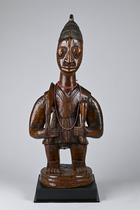Shrine image "ogo eshu" / "elegba" · Nigeria, Yoruba, Oyo, Igbuke (Ibuje) · ID: 3049721
Paolo Morigi (1939-2017), Magliaso-Lugano, Switzerland
Sotheby’s, Paris, “Collection Paolo Morigi (2e Partie). Art Africain et Océanien”, 6 December 2005, Lot 83
Native, Brussels, 9 June 2012, Lot 27
Description
wood, glass beads, nails, base
This figure is carved in the style of the Igbuke (or Ibuje) family of carvers from Oyo. A very similar figure from the same workshop published by Klever,1975, p. 108, ill. 88 (AHDRC 0109182).
In the Yoruba pantheon, “eshu” represents one of the most respected deities (“orisha”). He is considered to be a mediator between the people and the gods. “Eshu” requires constant appeasement in order to carry out his assigned functions.
The most impressive cult objects are altar figures such as the present one, which always shows “eshu” with a long braid and in clothes. Insignia such as fly whisk and club refer to his respected position. Sculptures of this type are kept wrapped in cloth and are only placed in the shrine during the annual “eshu” festival, when animal sacrifices are made there.
Because of his devious pranks, he is counted among trickster gods and mythical villains. He is full of contradictions. He likes to provoke quarrels between people, but is also considered a peacemaker. He causes misfortune, but can also make you rich and happy.
“Eshus” anarchical nature and immoderate sexuality are manifestations of the enormous power given him by “olodumare”, creator and maintainer of the world, which enabled him to promote change and growth. An equally strong determinant of his character is “eshus” association with the god of divination, “ifa”.
Due to his destructive potential, “eshu” is usually worshipped outside
the home. A pile of clay doused with palm oil, the offering preferred by
“eshu”, at the entrance to the house represents the god. “Eshu” is said
to keep bad luck away from the house.
Comparing literature
Klever, Ulrich, Bruckmann's Handbuch der afrikanischen Kunst, München 1975, p. 108, ill. 88
Publications
Morigi, Paolo, "Raccolta di un amatore d'arte primitiva", Bern 1980, p. 176, ill. 172; Expo cat.: "Kunst aus Afrika und Ozeanien. Eine unbekannte Privatsammlung / Art d'Afrique et d'Océanie. Une collection privée inconnue", Bern: Kunstmuseum / Musée des Beaux-Arts de Berne, 1980: cat.172 (not illustrated); Vogelzang, J., "Op zoek naar schrijnfiguren van de Yoruba Trickster - Orisha Eshu / Elegba", Vereniging Vrienden van Ethnografica, no. 100, 2007, p. 45, E
AHDRC: 0109183
Exhibition
Bern, Switzerland: "Kunst aus Afrika und Ozeanien. Eine unbekannte Privatsammlung", Kunstmuseum Bern, 22 August - 2 November 1980






